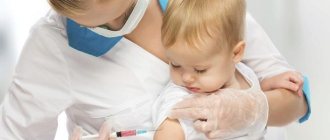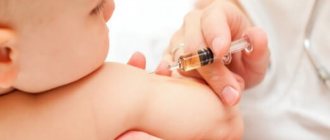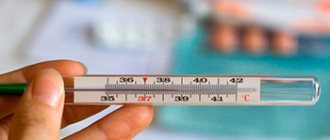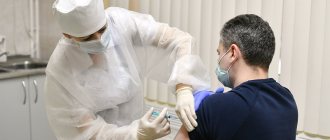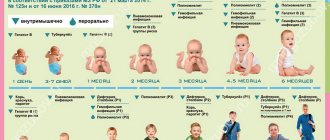Measles is an acute viral infection, which is characterized by fever, the development of catarrhal symptoms and the appearance of a specific rash. Measles is highly contagious. Transmitted from person to person by airborne droplets. The disease develops approximately 10 days after exposure.
Manifestations of the disease begin with fever, runny nose, and cough. Conjunctivitis and photophobia develop. From about 4 days of illness, a characteristic rash appears on the mucous membranes of the oral cavity and on the skin. The skin rash appears in stages starting from the head. Then moves on to the torso, arms and legs. By day 4, the rash begins to darken and peel. Then it disappears in the same sequence in which it appeared. There is no specific treatment for measles. Complications of infection occur in about a quarter of cases. These include: bronchitis, sinusitis, pneumonia and encephalitis.
Measles is a highly contagious infection; upon contact with a sick person, 9 out of 10 unvaccinated children become infected. The measles virus tends to infect the cells of the child’s immune system. This entails a high risk of infectious complications. In the pre-vaccination era, measles was one of the leading causes of child mortality. In addition, measles is often complicated by a disease of the nervous system. Measles encephalitis develops in approximately one in 300 affected children and has no specific treatment. Due to the high “infectiousness”, outbreaks of measles still occur in the world, especially in communities with low vaccination coverage.
Rubella is a viral infection characterized by mild catarrhal symptoms and the appearance of a rash. Rubella has a long incubation period. It takes 2-4 weeks from infection to the development of the disease. In this case, a person becomes infectious already in the middle of the incubation period and remains infectious after the rubella rash disappears. The first symptoms of the disease are nonspecific - a slight increase in temperature, a slight runny nose, weakness, and enlarged lymph nodes. After about 2 days of illness, a characteristic pinpoint bright rash appears. First on the head, then gradually descends to the limbs. After a few days, the rash goes away on its own without leaving a trace. Rubella in children is usually not severe. Rarely leads to complications.
Rubella has a mild course in children. However, due to the fact that the patient is contagious for a long time, even without a clinic, rubella spreads easily. Rubella infection is extremely dangerous for pregnant women, especially in the first trimester of pregnancy. In about a quarter of cases, women who have had rubella give birth to babies with one or another severe pathology. The most common of them is congenital cataracts (visual impairment, including blindness).
Mumps (mumps) is an acute infectious disease characterized by damage to the endocrine glands (usually the parotid salivary gland). The virus is transmitted by airborne droplets, less often by contact (from contaminated surfaces). The disease has a long incubation period - approximately 16-18 days. However, from the middle of the incubation period, the child can be contagious. The disease begins with a slight increase in temperature, general weakness, and dry cough. On days 2-3, the parotid salivary glands enlarge. After about a week, the size of the glands begins to decrease and the patient recovers. In some cases, recovery does not occur, complications appear - damage to the pancreas, mammary or gonads, nervous system, hearing impairment. It is important to note that mumps has no specific treatment.
Online consultation with pediatrician Olga Nikolaevna Tekutyeva
Registration online
During the consultation, you will be able to voice your problem, the doctor will clarify the situation, interpret the tests, answer your questions and give the necessary recommendations.
Mumps is often not severe and rarely causes complications. But these complications persist for life. These include infertility, deafness or the development of diabetes. In addition, those who have had mumps do not always develop immunity. The disease may recur in adulthood. The risk of complications in adults increases significantly.
What vaccinations are there for measles, rubella and mumps?
All measles, rubella, and mumps vaccines are live attenuated vaccines. This means that the drug contains live viruses grown under artificial conditions and “weakened” in a special way. So that they cannot cause a full-fledged disease, but at the same time they form stable lifelong immunity. Attempts to create inactivated (non-live) vaccines against these infections have been unsuccessful. Such vaccines turned out to be too “weak”, unable to induce lasting immunity.
Among the vaccines are:
— monovaccines. Separately mumps, measles and rubella;
- divaccines. The mumps-measles vaccine is widespread in our country;
- and trivaccines. This group includes the MMP and Priorix vaccines. Such vaccines are preferable because instead of two or three injections, the child receives only one injection.
Compatibility with other vaccines
The MMR-II vaccine should be administered one month before or after the administration of other live viral vaccines. Coadministration of measles, mumps, and rubella vaccine is not recommended with DPT or oral poliovirus vaccine.
Immunoglobulin should not be prescribed simultaneously with MMP-II.
If a tuberculin test (Mantoux test) is necessary, it should be done either before or simultaneously with vaccination with MMP-II.
When is the measles, rubella and mumps vaccine given?
According to the national vaccination calendar, the vaccine (or 2 vaccines, separately rubella and mumps-measles) is administered at 12 months. This age was chosen because until about 11 months the child can retain immunity transmitted in utero from the mother.
The second vaccination is given at 6 years of age. Repeated administration is recommended because the first vaccination provides approximately 70–80% protection against infection. Repeated vaccination increases the level of protection to approximately 95%.
Separately, the calendar provides for vaccinations for girls from 18 to 25 years old. To prevent the development of congenital rubella in children.
Rubella vaccination and pregnancy.
It has been proven that antibodies after rubella vaccination last for approximately 10 - 20 years.
- If a woman planning a pregnancy is sure that she was vaccinated no more than 10 years ago, and has received at least 2 vaccinations throughout her life, she can safely plan a pregnancy.
- The second option is if the woman has not been vaccinated, the vaccination schedule has not been completed, or she does not know which vaccinations were given and when. Before planning a pregnancy, it is better to get vaccinated against rubella.
- If a woman has been vaccinated twice, but more than 10 years have passed since vaccination. In this case, before planning a pregnancy, you can take a blood test for antibodies. If the antibody level is sufficient, you can plan a pregnancy. If the level of antibodies decreases or is absent, the woman is recommended to get vaccinated.
Mumps, measles and rubella - why are they dangerous?
Today, measles, mumps and rubella have been and remain in first place in terms of distribution among diseases of viral origin.
Therefore, the issue of immunization against them is very acute. Since these diseases most often attack children, the complex vaccination “measles, rubella, mumps” is one of the most important. What is the danger of these diseases? And isn't vaccination against them more dangerous?
What are these diseases?
Measles, rubella, and mumps, the consequences of which can be very severe, are transmitted by airborne droplets. And therefore they spread very quickly. To diagnose these viral diseases, it is enough to know their characteristic symptoms.
Measles is manifested by inflammation of the mouth, mucous membranes of the respiratory tract, a pinkish rash and an increase in body temperature. Among other things, symptoms of intoxication of the body are observed: dizziness, nausea, weakness.
Rubella is also accompanied by a rash, but it is small and red. With the appearance of pimples, intoxication of the whole body occurs, and the lymph nodes become enlarged. When rubella affects a woman during pregnancy, the baby in the womb becomes infected with it.
Mumps, the symptoms of which are more recognizable in children and adults, is a very insidious disease. In addition to the nervous system, it also affects the parotid glands. Mumps (mumps in folklore), which occurs in males, can cause infertility.
Regarding diseases such as measles, rubella, mumps, vaccination is an effective way to avoid complications after them.
Mumps in boys and infertility
The consequences of mumps in boys are more dangerous. Indeed, in addition to the salivary glands, the disease also affects the male reproductive glands. Inflammation of the testicles and their appendages usually appears 5-7 days after the first signs of mumps are detected. The testicles swell, turn red, increase in size, and become painful. Mumps, the photo of the external signs of which you see, has very clear symptoms.
Diagnosis "epid. mumps,” the treatment of which was not started on time, can threaten testicular atrophy. But not in all cases, mumps causes infertility in men. Particularly dangerous is mumps in adults, which affects testicular tissue. A semen analysis can help confirm that a man is infertile.
Mumps vaccination for boys is very important. But there is a hypothesis that this virus can also infect women’s ovaries, causing inflammation in them - oophoritis. Typically, this inflammatory process is asymptomatic and can cause infertility in women. However, the consequences of mumps in boys are one and a half times more common.
Vaccination against mumps
The most effective measure against these viral diseases has been and remains vaccination. As a rule, combined Priorix vaccinations for children with “measles, rubella, mumps” are given up to the age of one and a half years. The vaccine is injected under the skin in the shoulder area or under the shoulder blade. Revaccination of “measles, rubella, mumps” is carried out at six years of age. There are usually no symptoms associated with immunization. Only in some cases, the mumps vaccine can cause fever and minor malaise in a child. A cough may occur. When immunizing an adult, in addition to the above symptoms, joint pain may also be bothersome.
Vaccination against measles, rubella, mumps: contraindications
Measles, rubella, mumps (MMR) vaccination is contraindicated in certain categories:
- for malignant blood diseases;
- in the presence of tumors;
- in case of immunodeficiency.
Before immunization, you should make sure that the person is not allergic to any component of the vaccine. When revaccination is carried out, the body's reaction to the previous vaccination is taken into account. The “measles, rubella, mumps” vaccination, after which the reaction was in the form of increased body temperature, swelling and swelling of the injection site, may be contraindicated again. But you should always take into account that the consequences of the measles, rubella, mumps vaccine are often not as terrible as the complications of the diseases themselves.
Vaccination against diseases such as measles, rubella and mumps is contraindicated in pregnant women, just like other vaccinations.
Vaccination against measles, rubella and mumps is combined with vaccinations against whooping cough, tetanus, hepatitis B, diphtheria, and polio.
Vaccination "measles, rubella, mumps": complications
Recently, there has been increasing debate about the need for vaccination against viral diseases. They are associated, first of all, with complications and side effects arising from vaccinations and related diseases. The “measles, rubella, mumps” vaccination, reviews of which can be found on forums, in rare cases has the following complications:
- allergic reactions to some components of the vaccine. Usually the vaccine contains an antibiotic, as well as chicken or quail protein. After the measles, rubella, mumps vaccine, an allergy occurs almost immediately, manifested by redness and swelling of the skin at the injection site. To relieve these symptoms, hormonal ointments are used to improve blood circulation. For severe swelling, antihistamines are used. If the allergy is expressed in more serious manifestations - Quincke's edema, rash and urticaria, antihistamines are administered intramuscularly;
- damage to the nervous system, the symptoms of which are febrile convulsions. Such symptoms may occur 6-11 days after the measles, rubella, mumps vaccine was given. The temperature can rise above 390C, and seizures appear as a reaction to the increase in temperature. In this case, paracetamol-based antipyretics will help. It is important to see a doctor immediately. Perhaps such a reaction to the “measles, rubella, mumps” vaccine signals damage to the nervous system and requires a neurologist;
- vaccine-associated diseases. They occur extremely rarely, but are very dangerous in nature. Among these is post-vaccination encephalitis, which affects brain tissue. This complication is common in people with immunodeficiency;
- It also happens that mumps occurs after MMR vaccination;
- rarely, serous meningitis (an inflammatory process in the membranes of the brain) may also occur.
Prevention of complications after vaccination
The main prevention of mumps, measles and rubella is vaccination. And to avoid negative consequences after vaccination, you need to follow some rules:
- preliminary use of antihistamines if the child is prone to allergic reactions;
- for chronic diseases of the nervous system, it is necessary to undergo their treatment before the “measles, rubella, mumps” vaccination in order to avoid exacerbation of these ailments after vaccination;
- on the day of vaccination the child must be completely healthy;
- After vaccination, avoid contact with sick people and refrain from visiting educational institutions.
Before vaccination, you need to undergo a general urine and blood test and be examined by a pediatrician or therapist for infectious diseases.
rubella, measles, mumps
What complications can occur after vaccination against measles, mumps and whooping cough?
All adverse reactions can be divided into 2 large groups: nonspecific and specific.
Nonspecific reactions usually occur no later than the third day after vaccination. These include:
-increase in temperature to insignificant figures. This symptom is uncommon and can be controlled by taking an antipyretic;
- at high temperatures, febrile convulsions may occur in children with a predisposition. This is a benign condition that usually goes away with age and does not require specific treatment. However, a child with an attack of such seizures must be observed by a doctor. The vaccination schedule for children who have such a reaction to vaccination should be compiled individually;
- general disturbance of well-being - weakness, drowsiness or, conversely, anxiety and sleep disturbance. This goes away on its own and does not require correction;
-swelling and redness at the injection site. With such vaccines, this symptom is rare, goes away on its own and does not require treatment;
- acute allergic reactions. A very rare side effect for this type of vaccine. Occurs in approximately 1 case out of 3.5 million vaccinations. It develops in the first hour after receiving the vaccine and requires qualified medical care. In order to have time to help a baby who has developed an acute allergic reaction, the mother must spend the first 30-40 minutes. After vaccination, they are asked to stay in close proximity to the medical facility.
Specific reactions occur because the vaccine contains a live, weakened virus. Such reactions do not occur immediately, but 2-3 weeks after vaccination. These include:
- general malaise, symptoms of mild ARVI;
- a slight rash on the body that goes away on its own after a few days;
- mild swelling and tenderness of the parotid salivary glands;
- temporary decrease in blood platelet levels.
All these symptoms do not require treatment.
How to prepare a child for vaccination?
No preliminary preparation is required for vaccination. The child should not suffer from an acute infection. Before vaccination, consultation with a pediatrician is required.
Reactions after vaccination
Usually, in most vaccinated children, vaccination against the above diseases does not cause any reactions. Sometimes reactions can occur within 21 days, most often 10-14 days after vaccination.
- Slight enlargement of lymph nodes;
- An increase in temperature can remain no higher than 37.6 degrees;
- The appearance of a rash;
- Hyperemia of the injection site;
- Joint pain;
- In some cases, the appearance of measles-like syndrome;
- Swelling of the salivary glands.
When should you not get the measles, rubella and mumps vaccine?
- If the child has had severe allergic reactions to an aminoglycoside antibiotic in the past.
- Severe immunodeficiency conditions (HIV infection, cancer, blood diseases). However, during the period of remission and under the supervision of the attending physician, such children can be vaccinated.
- The period of pregnancy and breastfeeding.
- Severe reaction to the previous administration of the drug (temperature above 40*C, severe redness and swelling).
- Vaccination is temporarily postponed if the child has an acute infection or an exacerbation of a chronic disease.
Types of vaccines
When immunizing the population, different types of vaccines can be used. Differing from each other in the type of viruses included in the immunobiological preparation, they are divided into monocomponent, two-component and three-component. The first two involve administering vaccines to different parts of the body. Today, children and adults have the opportunity to be vaccinated with both domestic and imported drugs. The quality of the serum and the result are no different.
Ervevax (Belgium)
A monovaccine used to prevent the development of rubella. It includes the highly attenuated strain Wistar RA 27/3, as well as neomycin B sulfate - no more than 25 µg per dose of the drug. The seroconversion rate (production of antibodies by the body) of such an immunobiological drug is 100%. Specific immunity persists for 16 years after the last vaccination.
Ervevax is available for administration on the same day when the DPT, DPT, polio, measles, and mumps vaccinations will be administered. The main thing is to use different syringes for each drug containing the virus, and inject the vaccines into different parts of the body. Patients who received immunoglobulins are allowed to undergo immunization with such a vaccine 3 months after treatment. If human blood products were administered less than 14 days after vaccination, the latter should be repeated.
Prevention of rubella in children with the Ervevax vaccine can begin at 12 months. As for immunization of patients with a history of seizures, it is recommended that they be vaccinated from 2 years of age. The immunization procedure should be carried out with extreme caution in people prone to allergies. Vaccination is not allowed for patients with primary/secondary immunodeficiency, acute diseases and chronic diseases in the acute stage, and pregnant women.
Measles cultural live dry vaccine (Russia)
A monovalent vaccine aimed at combating measles. It includes a virus (~1000 tissue cytopathogenic doses), as well as a stabilizer, gentamicin sulfate - no more than 0.5 μg per dose of the drug. The development of stable immunity to measles after vaccination with such a monovaccine reaches its peak 3 to 4 weeks after immunization.
The vaccine is completely safe and meets WHO recommendations.
Immunization with such a vaccine can be carried out with other NKPP vaccinations. In particular, it allows parallel immunization with the prevention of hepatitis B, whooping cough, diphtheria, polio, and other types of disease. After treatment with immunoglobulins, measles vaccination should be done after 3 months. After immunosuppressive therapy - no earlier than 3-6 months after its completion.
Routine vaccinations with the monovaccine are given to patients 12 months of age. Children who were born to mothers previously unvaccinated against this disease are vaccinated at 8 months. Further, according to the recommendations of the schedule of preventive vaccinations. Persons with a temporary medical exemption from vaccinations are subject to immunization after the removal of contraindications. Among the latter are pregnancy, immunodeficiency conditions, blood diseases, and oncology.
Mumps-measles vaccine (Russia)
A two-component vaccine used as part of the immunization of the population against measles and mumps. It contains the causative agents of the virus of the two above-mentioned diseases, as well as a stabilizer and gentamicin sulfate - no more than 0.5 µg per dose of the drug. The required level of antibodies for the administration of such a drug reaches its maximum values 3–4 weeks after vaccination. Stable immunity to diseases lasts for 10 years. Afterwards revaccination is required.
Immunization using such a vaccine can be carried out on the same day as DTP, ADS vaccinations, prevention of polio, hepatitis B, rubella, influenza, Haemophilus influenzae. Administration of other live vaccines is allowed after 1 month (in order to prevent the risk of drug inactivation). In cases where it is necessary to perform a Pirquet test, it is performed either together or 6 weeks after mumps-measles vaccine prophylaxis. As for human immunoglobulin preparations, their use is resumed after 2 months.
Vaccination against measles and mumps can be given to children from 12 months. In this case, it should be temporarily abandoned during the period of increased incidence of serous forms of meningitis. It should be remembered: the mumps-measles vaccine has a number of medical contraindications. These include pregnancy and breastfeeding, disorders of the immune system, allergic reactions to aminoglycosides, chicken and/or quail eggs.
Priorix (Belgium)
A three-component vaccine that protects the body from measles, rubella, and mumps. It contains the Schwartz strain, strain RIT 43/85, strain Wistar RA 27/3, as well as neomycin B sulfate - no more than 25 µg per dose of the drug. According to clinical trials, Priorix has high seroconversion rates.
So, in particular, antibodies to rubella are observed in 99.3%, to measles - in 98%, to mumps - in 96.1% of patients vaccinated with a vaccine containing three strains of the disease.
Priorix can be used in parallel with the DPT, DPT, polio, hepatitis B, Haemophilus influenzae vaccines. The main rule is not to allow drugs to be mixed in one syringe, and to place vaccinations in different places. Immunization using such a vaccine can be carried out both after previous vaccination with a combination vaccine, and after vaccination with monovalent drugs. If you need to take immunoglobulins afterwards, you should wait 2 weeks. Otherwise, the MMR vaccination will not have the desired effect on the body of the person being vaccinated.
In accordance with the NKPP, Priorix is initially administered to patients for 12 months. Revaccination is carried out at the age of 6 years. Further, every 10 years after the last vaccination. The option of using the vaccine during breastfeeding is allowed. It is strictly forbidden to use it for vaccination of patients with immunodeficiency conditions, hypersensitivity to neomycin, chicken egg white.
Measles vaccine and autism
In 1998, a British scientist published an article in a scientific journal that the preservative merthiolate contained in the measles vaccine causes inflammatory bowel disease and autism in children. A little later, other researchers refuted the article and established that the facts in it were manipulated. And the author himself admitted that he published his research for commercial purposes. He wanted to support sales of the vaccine without merthiolate. The article was refuted, the scientist was deprived of all regalia and the title of doctor.
The publication managed to generate so many rumors that even now at receptions I often hear speculation about a connection between vaccinations and autism. Since then, a large amount of research has been carried out. The last, long-term one, involving 400 thousand vaccinated children, ended in 2020.
None of the studies have confirmed the link between vaccination and autism. Unfortunately, the causes of this disease have not yet been established.
